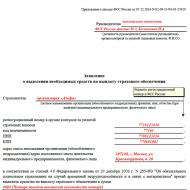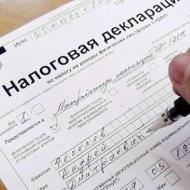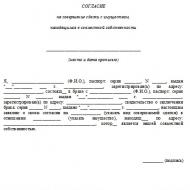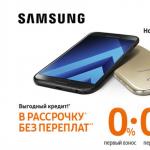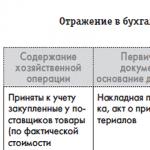
Deduction for expensive medications. Documents: List of medicines. Other drugs that affect the muscles of the uterus
About 100 million rubles are spent annually from the state treasury of the Russian Federation on drug provision for preferential categories of citizens. This measure allows access to necessary medicines to sections of the population. But not everyone is aware of their right to a list of medications under federal or local law. According to the latter, the conditions for issuing drugs, their quantity, names and persons claiming preference, vary at the discretion of regional authorities.
The Federal Law establishes general rights for all citizens of the Russian Federation, regardless of financial status and nationality. Benefits depend on belonging to a special category (disabled, veteran, low-income).
Unfortunately, you can only receive medications on one of the grounds (although there is no direct ban on the simultaneous use of federal and regional preferences), so the recipient will have to make a choice. The payment for medicines to the state beneficiary is carried out by the Pension Fund, and to the regional beneficiary - by the social protection body.
How to get a tax deduction for the purchase of medicines: 1) Collect all prescriptions and receipts, 2) Prepare a 3-NDFL declaration, 3) Obtain a 2-NDFL certificate from your employer, 4) Submit all this to the Federal Tax Service and wait for the money after 4 months.
Tax deduction for medicines - how to get it
Not many citizens know that for some purchased medications it is allowed to return a certain part of their cost. And this is so! Reimbursement of personal income tax for medicines is directly provided for by the Tax Code, but taking into account some nuances.
Let’s make a reservation right away that the state will not return the money paid for all drugs. To reimburse expenses, the following conditions must be met:
- The drug was purchased at my own expense. There are documents (receipts) confirming expenses made on medicines.
- The medications were purchased with a doctor’s prescription, meaning there are clear medical indications for taking this drug.
- The purchased medications are included in the list of medications for tax deduction 2020 (Resolution of the Government of the Russian Federation dated March 19, 2001 No. 201).
- IN reporting period citizen received wages and/or other income subject to personal income tax at a rate of 13%.
Refunds of personal income tax for medicines are classified as social deductions (subclause 3, clause 1). Therefore, the amount of such a deduction is 120,000 rubles per year. In other words, if a citizen purchased medicines worth 120,000 rubles in a calendar year, then the state will return to him 13% of the withheld personal income tax (15,600 rubles).
IMPORTANT! If a citizen earned less income in the reporting period maximum size social tax (120,000 rubles), then he is entitled to compensation in the amount of personal income tax actually withheld.
For example, Bukashka A.B. in 2019, he received income in the amount of 100,000 rubles, and purchased medicines in the amount of 120,000 rubles. Consequently, he will be able to return only 13,000 rubles. (100,000 × 13%).
Drug deduction calculator: calculate the amount
Calculate how much you can return for purchased medications. Enter the amount you purchased for medicines last year, click the “Calculate” button - and you will receive the amount that you can legally return.
Cost of medicine
Rub.
Result
List of medicines for tax deduction
As we mentioned earlier, not all medications are entitled to personal income tax refund. To eliminate controversial situations, officials have developed and approved an exhaustive list of medications for which you are entitled to receive a personal income tax refund. Government Decree No. 201 of March 19, 2001 (in latest edition dated June 26, 2007) contains this list.
Note that in legal act non-proprietary international names of drugs are named. That is, only pharmacological names are listed, without reference to manufacturers, brands and other features. And one drug can have several different names, can be produced by different companies, in different countries. Pay attention to this non-proprietary name. A simple example: the pharmacological name “acetylsalicylic acid” is the brand “Aspirin”.
We invite you to download the full list of medicines for tax deduction in 2020 (the entire list from Resolution No. 201) at the end of the article. Here are just a few examples (this is our short list of medications):
- Anesthesia: Ketamine (solution), Diethyl ether (liquid in vials)
- Local anesthetics: Lidocaine (all forms)
- Non-narcotic analgesics: Acetylsalicylic acid (aspirin), Diclofenac, Ibuprofen
- Antihistamines: Quifenadine, Ketotifen
- Antidepressants: Amitriptyline, Lithium carbonate, Sertraline
- Antibacterial: Ampicillin, Gentamicin, Norfloxacin, Erythromycin
- Antiviral agents: Acyclovir, Indinavir
- Antifungals: Clotrimazole, Fluconazole
- Drugs for the treatment of osteoporosis: Alendronic acid, Calcium carbonate + ergocalciferol
- Antianemic agents: Ferrous sulfate, Folic acid
- Drugs for the treatment of heart failure: Valsartan, Captopril, Enalapril
- Antiseptics: Iodine, Hydrogen Peroxide, Chlorhexidine
- Insulin and drugs used for diabetes mellitus: Insulin DlD, KD, Comb, SrD
- Vitamins: Menadione, Thiamine
- Some other categories.
You can check which medications can receive a tax deduction and whether the purchased drug is included in the government list on the official website of Rosminzdrav. But let us remind you that we have provided a list of medications for which you can receive a tax deduction for downloading as a file and saving for the future at the end of this article.
Procedure for receiving personal income tax refund for medicines
They receive a personal income tax refund through the tax office, waiting for the next calendar year, or directly through the employer in the same reporting period. In both cases, in order to apply for a tax deduction for medicines, the following list of documents will have to be sent to the Federal Tax Service:
- for the calendar year in which the drugs were purchased. If a citizen wishes to return tax through an employer, then a declaration is not submitted to the Federal Tax Service.
- Certificate of income received in the reporting period.
- Prescriptions for prescribed medications with a special note that the document was drawn up for the Federal Tax Service.
- Documents confirming payment for medications. For example, receipts or cash receipts.
In addition to this package of documents, you should draw up an application for the return of personal income tax, in which you should indicate the details bank account, to which the Federal Tax Service will credit the compensation.
The declaration must be submitted no later than April 30. Federal Tax Service inspectors consider such requests and conduct desk audits within three months. You will be notified in writing of the receipt of documents and the start of the desk audit. The funds to be returned to the citizen will be credited to the bank account 30 days after the end of the desk audit.
If relatives paid for treatment
If actual expenses for medicines were made by close relatives, then it is possible to receive a deduction.
IMPORTANT! Close relatives are spouses, parents (guardians) and minor children (natural and adopted).
In this case, in addition to the above package of documentation, certified copies of documents confirming family ties should also be submitted to the Federal Tax Service. For example, a birth certificate for a child under 18 years of age or a marriage certificate.
If another relative, common-law spouse or friend paid for the medicines, then in order to receive a tax refund you must issue a power of attorney for the purchase of medicines. Such a power of attorney does not need to be certified by a notary (Letters of the Federal Tax Service for Moscow dated March 10, 2010 No. 20-14/4/024732 @, Federal Tax Service of the Russian Federation dated May 17, 2012 No. ED-4-3/8135).
Vitasite https://www.siteList of medicines prescribed by the attending physician to the taxpayer and purchased by him at the expense of own funds, the value of which is taken into account when determining the amount of social tax deduction
(Approved by Decree of the Government of the Russian Federation dated March 19, 2001 N 201 “On approval of lists medical services and expensive types of treatment in medical institutions of the Russian Federation of medicines, the amount of payment for which at the expense of the taxpayer’s own funds is taken into account when determining the amount of social tax deduction.” As amended and supplemented on June 26, 2007)
Section 1. Anesthetics and muscle relaxants
Anesthetics
- Halothane (solution for inhalation anesthesia in vials)
- Hexobarbital (powder for injection)
- Dinitrogen oxide (gas in cylinders)
- Ketamine (injection solution)
- Sodium oxybate (injection solution)
- Sodium thiopental (lyophilized powder for injection)
- Diethyl ether (liquid in bottles)
Local anesthetics
- Bupivacaine (injection)
- Lidocaine (aerosol, injection solution, gel, solution in capsules, eye drops)
Muscle relaxants
- Atracurium besilate (injection solution)
- Botulinum toxin, albumin (lyophilized powder for injection)
- Vecuronium bromide (powder for injection)
- Pipecuronium bromide (powder for injection)
- Suxamethonium bromide (powder)
Section 2. Analgesics, non-steroidal anti-inflammatory drugs, drugs for the treatment of rheumatic diseases and gout
Narcotic analgesics
- Morphine (injection solution, tablets)
- Morphine + narcotine + papaverine + codeine + thebaine (injection solution)
- Pentazocine (injection solution, tablets)
- Piritramide (injection solution)
- Trimeperidine hydrochloride (injection solution, tablets)
- Fentanyl (injection solution)
Non-narcotic analgesics and non-steroidal anti-inflammatory drugs
- Acetylsalicylic acid (tablets)
- Diclofenac sodium (tablets, dragees, injection solution, suppositories, gel, eye drops)
- Ibuprofen (capsules, tablets, syrup, cream)
- Ketoprofen (tablets, capsules, suppositories, gel, powder for solution)
- Lornoxicam (tablets, lyophilized powder for injection solution)
- Meloxicam (tablets, suppositories)
- Nalbuphine (solution for injection)
- Tramadol (injection solution, capsules, tablets, oral drops, suppositories)
Medicines for the treatment of gout
- Allopurinol (tablets)
Other means
- Colchicine (tablets, dragees)
- Penicillamine (tablets, capsules, dragees)
Section 3. Medicines used to treat allergic reactions
Antihistamines
- Quifenadine (tablets)
- Ketotifen (tablets, capsules, syrup)
- Chloropyramine (tablets, solution for injection)
Section 4. Drugs affecting the central nervous system
Anticonvulsants
- Valproic acid (tablets, capsules, syrup, dragees, suspension, drops)
- Carbamazepine (tablets)
- Clonazepam (tablets, drops, injection solution)
- Lamotrigine (tablets)
- Phenytoin (tablets)
- Phenobarbital (tablets, oral solution)
- Ethosuximide (capsules)
Drugs for the treatment of parkinsonism
- Amantadine (tablets, solution for injection)
- Biperiden (tablets, solution for injection)
- Levodopa + benserazide (capsules)
- Levodopa + carbidopa (tablets)
- Trihexyphenidyl (tablets)
Sedatives and anxiolytics, drugs for the treatment of psychotic disorders
- Haloperidol (tablets, solution for injection)
- Diazepam (tablets, injection solution, suppositories)
- Zuclopenthixol (tablets, solution for injection)
- Clozapine (tablets, injection solution)
- Levomepromazine (tablets, solution for injection)
- Lorazepam (tablets)
- Medazepam (tablets, granules, capsules)
- Nitrazepam (tablets)
- Periciazine (drops, capsules)
- Perphenazine (tablets)
- Pipothiazine (solution for injection, drops)
- Sulpiride (tablets, injection solution, capsules, oral solution)
- Thioproperazine (tablets, solution for injection)
- Thioridazine (tablets, dragees)
- Trifluoperazine (tablets, solution for injection)
- Phenazepam (tablets, solution for injection)
- Fluspirilene (solution for injection)
- Fluphenazine (solution for injection)
- Chlorpromazine (tablets, injection solution, dragees)
- Chlorprothixene (tablets)
- Antidepressants and mood stabilizers
- Amitriptyline (tablets, injection solution, dragees)
- Imipramine (tablets, dragees, solution for injection)
- Clomipramine (tablets, dragees, solution for injection)
- Lithium carbonate (tablets, capsules)
- Maprotiline (tablets, dragees, solution for injection)
- Mianserin (tablets)
- Moclobemide (tablets)
- Sertraline (tablets)
- Tianeptine (tablets)
- Fluoxetine (tablets, capsules)
- Citalopram (tablets)
Medicines for the treatment of sleep disorders
- Zolpidem (tablets)
Medicines for the treatment of multiple sclerosis
- Glatiramer acetate (lyophilized powder for injection)
- Interferon beta (lyophilized powder for injection)
Means for the treatment of alcoholism and drug addiction
- Naloxone (injection solution)
- Naltrexone (tablets, capsules)
- Anticholinesterase drugs
- Distigmine bromide (tablets, solution for injection)
- Neostigmine methyl sulfate (tablets, solution for injection)
- Pyridostigmine bromide (tablets, dragees, solution for injection)
Other drugs affecting the central nervous system
- Vinpocetine (tablets, solution for injection)
- Hexobendine+etamivan+etophylline (tablets, solution for injection)
- Nimodipine (tablets, solution for infusion)
Section 5. Means for the prevention and treatment of infections
Antibacterial
- Azithromycin (tablets, powder, syrup)
- Amikacin (powder for injection, solution for injection)
- Amoxicillin + clavulanic acid (injection solution)
- Ampicillin (tablets, capsules, powder for injection)
- Benzathine benzylpenicillin (powder for injection)
- Benzylpenicillin (powder for injection)
- Vancomycin (powder for injection)
- Gentamicin (ointment, cream, injection solution, eye drops)
- Josamycin (tablets, suspension)
- Doxycycline (tablets, capsules, powder for injection)
- Imipenem (powder for injection)
- Carbenicillin (powder for injection)
- Clarithromycin (tablets)
- Co-trimoxazole (tablets, suspension, solution for injection)
- Lincomycin (capsules, ointment, solution for injection)
- Meropenem (powder for injection)
- Mesalazine (suspension)
- Mupirocide (ointment)
- Norfloxacin (tablets, eye drops)
- Pefloxacin (tablets, solution for injection)
- Spiramycin (tablets, granules for suspension)
- Sulfacetamide (eye drops)
- Chloramphenicol (tablets, capsules, powder for injection, eye drops)
- Cefaclor (capsules, granules, syrup, suspension)
- Cefaperazone (powder for injection)
- Cefipime (powder for injection)
- Cefotaxime (powder for injection)
- Ceftazidime (powder for injection)
- Ceftriaxone (powder for injection)
- Cefuroxime (powder for injection)
- Ciprofloxacin (tablets, injection solution, eye drops)
- Erythromycin (tablets, ointment, syrup, ampoules)
Antituberculosis drugs
- Isoniazid (tablets, solution for injection)
- Lomefloxacin (tablets)
- Pyrazinamide (tablets)
- Prothionamide (tablets)
- Rifabutin (capsules)
- Rifampicin (capsules, powder for injection)
- Streptomycin (powder for injection)
- Ethambutol (tablets, dragees)
- Ethionamide (dragée)
Antiviral agents
- Acyclovir (tablets, ointment, cream, powder for injection)
- Ganciclovir (capsules, powder for injection)
- Didanosine (tablets, powder for oral solution)
- Zidovudine (capsules, syrup, solution for injection)
- Indinavir (capsules)
- Ifavirenz (capsules)
- Lamivudine (tablets, solution for internal use)
- Nevirapine (tablets, suspension)
- Stavudine (capsules, powder for oral solution)
Antifungal agents
- Amphotericin B (ointment, powder for injection)
- Amphotericin B + methylglucamine (tablets)
- Griseofulvin (tablets, liniment, suspension)
- Itraconazole (capsules)
- Clotrimazole (vaginal tablets, cream, aerosol, solution)
- Terbinafine (tablets, cream)
- Fluconazole (capsules, solution for injection)
- Antiprotozoal and antimalarial drugs
- Hydroxychloroquine (tablets)
- Metronidazole (tablets, injection solution, suppositories)
- Chloroquine (tablets, injection solution)
Other means
- Bifidumbacterin (tablets, powder for suspension)
Vaccines and serums
- Immunobiological preparations (for the diagnosis and prevention of infectious diseases in accordance with the epidemiological situation in the regions Russian Federation)
- AIDS diagnostic system test
Section 6. Antineoplastic, immunosuppressive and related drugs
Cytostatic agents
- Azathioprine (tablets)
- Aranose (powder for injection)
- Asparaginase (powder for injection)
- Bleomycin (powder for injection)
- Busulfan (tablets)
- Vinblastine (lyophilized powder for injection)
- Vincristine (lyophilized powder for injection, solution for injection)
- Vinorelbine (solution for injection)
- Gemcitabine (lyophilized powder for injection)
- Hydroxyurea (capsules)
- Dacarbazine (powder for injection)
- Dactinomycin (powder for injection, solution for injection)
- Daunorubicin (powder for injection)
- Doxorubicin (powder for injection)
- Docetaxel (concentrate for injection solution)
- Idarubicin (capsules, lyophilized powder for injection)
- Irinotecan (solution for infusion)
- Ifosfamide (powder for injection)
- Calcium folinate (solution for injection)
- Carboplatin (powder for injection, solution for injection)
- Carmustine (lyophilized powder)
- Clodronic acid (capsules, concentrate for the preparation of infusion solution)
- Melphalan (tablets, powder for injection)
- Mercaptopurine (tablets)
- Methotrexate (tablets, powder for injection, solution for injection)
- Mitoxantrone (solution for injection, concentrate for infusion)
- Mitomycin (powder for injection)
- Oxaliplatin (powder for the preparation of infusion solution)
- Paclitaxel (solution for injection, concentrate for infusion)
- Procarbazine (capsules)
- Prospidia chloride (lyophilized powder, ointment)
- Thioguanine (tablets)
- Thiotepa (lyophilized powder for injection)
- Tretinoin (capsules)
- Fludarabine (powder for injection)
- Fluorouracil (solution for injection, concentrate for infusion)
- Chlorambucil (tablets)
- Cyclophosphamide (tablets, dragees, solution for injection)
- Cisplatin (lyophilized powder for injection, solution for injection)
- Cytarabine (powder for injection, solution for injection)
- Epirubicin (lyophilized powder for injection)
- Etoposide (solution for injection)
Hormones and antihormones
- Aminoglutethimide (tablets)
- Anastrozole (tablets)
- Ganirelix (solution for injection)
- Goserelin (capsules - depot)
- Medroxyprogesterone (tablets, granules, injection suspensions)
- Tamoxifen (tablets)
- Triptorelin (injection solution, lyophilized powder for injection solution)
- Flutamide (tablets)
- Cetrorelix (lyophilized powder for injection solution)
Related products
- Interferon alpha (powder for injection, solution for injection, suppositories)
- Lenograstim (lyophilized powder for injection)
- Molgramostim (lyophilized powder for injection)
- Ondansetrion (tablets, solution for injection)
- Filgrastim (solution for injection)
Section 7. Drugs for the treatment of osteoporosis
Osteogenesis stimulants
- Alendronic acid (tablets)
- Alfacalcidol (capsules)
- Calcitonin (powder for injection)
- Calcium carbonate + ergocalciferol (tablets)
Section 8. Drugs affecting blood
Antianemic drugs
- Iron hydroxide sucrose complex (solution for injection)
- Ferrous sulfate (tablets, dragees)
- Iron sulfate + ascorbic acid (tablets)
- Folic acid (tablets)
- Cyanocobalamin (injection solution)
- Epoetin beta (solution for injection)
- Drugs affecting the blood coagulation system
- Alpostadil (powder for solution for injection)
- Alteplase (lyophilized powder for injection)
- Heparin sodium (solution for injection)
- Nadroparin calcium (syringes with solution for injection)
- Pentoxifylline (tablets, solution for injection)
- Protamine sulfate (solution for injection)
- Streptokinase (powder for injection)
- Ticlopidine (tablets)
- Phenindione (tablets)
- Enoxaparin sodium (syringes with solution for injection)
Solutions and plasma substitutes
- Amino acids for parenteral nutrition (parenteral nutrition solution)
- Hemin (concentrate for the preparation of infusion solution)
- Dextrose (solution for injection, solution for infusion)
- Pentastarch (solution for infusion)
Plasma preparations
- Albumin (solution for infusion)
- Coagulation Factor VIII (powder for injection)
- Clotting factor IX (powder for injection)
Lipid-lowering drugs
- Simvastatin (tablets)
- Phospholipids + pyridoxine + nicotinic acid + adenosine monophosphate (solution for injection)
Section 9. Drugs affecting the cardiovascular system
Antianginal agents
- Isosorbide dinitrate (tablets, capsules, injection solution, aerosol)
- Isosorbide mononitrate (tablets, capsules)
- Nitroglycerin (tablets, capsules, patch, solution for injection)
Antiarrhythmic drugs
- Allapinin (tablets, solution for injection)
- Amiodarone (tablets, solution for injection)
- Atenolol (tablets)
- Metoprolol (tablets)
- Procainamide (tablets, solution for injection)
- Propafenone (tablets)
- Quinidine (tablets)
- Ethacizin (tablets)
Antihypertensives
- Azamethonium bromide (injection solution)
- Amlodipine (tablets)
- Betaxolol (tablets, eye drops)
- Verapamil (tablets, capsules, dragees, solution for injection)
- Doxazosin (tablets)
- Methyldopa (tablets)
- Nifedipine (tablets, capsules)
- Propranolol (tablets, solution for injection)
- Fosinopril (tablets)
Medicines for the treatment of heart failure
- Valsartan (tablets)
- Digoxin (tablets, drops, solution for injection)
- Irbesartan (tablets)
- Captopril (tablets)
- Quinapril (tablets)
- Perindopril (tablets)
- Enalapril (tablets, solution for injection)
Vasopressors
- Dobutamine (lyophilized powder for injection, concentrate for infusion)
- Dopamine (solution for injection, concentrate for infusion)
- Phenylephrine (injection solution, eye drops)
- Ephedrine (injection solution)
Section 10. Diagnostic tools
X-ray contrast agents
- Sodium amidotrizoate (solution for injection)
- Barium sulfate + sodium citrate + sorbitol + antifomsilan + nipagin (powder)
- Gadodiamide (injection solution)
- Gadopentetic acid (injection solution)
- Galactose (granules for injection solution)
- Iohexol (solution for injection)
- Iopromide (injection solution)
Fluorescent agents
- Fluorescein sodium (solution for injection)
- Radioisotope agents
- Albumin microspheres, 99mTs (reagent for preparation, lyophilized powder for solution preparation)
- Bromezide, 99Tc (reagent for preparation, lyophilized powder for solution preparation)
- Pentatekh, 99mTs (reagent for preparation, lyophilized powder for solution preparation)
- Pirfotech, 99mTs (reagent for preparation, lyophilized powder for preparing solution)
- Strontium 89 chloride isotonic solution (solution for injection)
- Technefit, 99Ts (reagent for preparation, lyophilized powder for preparing solution)
- Technefor, 99mTs (reagent for preparation, lyophilized powder for solution preparation)
Section 11. Antiseptics and disinfectants
Antiseptics
- Iodine (alcohol solution)
Disinfectants
- Hydrogen peroxide (solution)
- Chlorhexidine (solution)
- Ethanol (solution)
Section 12. Medicines for the treatment of diseases of the gastrointestinal tract
Antacids and other antiulcer drugs
- Omeprazole (capsules)
- Pirenzepine (tablets, solution for injection)
- Famotidine (tablets, solution for injection)
Antispasmodics
- Atropine (eye drops, solution for injection)
- Drotaverine (tablets, solution for injection)
- Platyfillin (solution for injection)
Pancreatic enzymes
- Pancreatin (tablets, capsules, dragees)
Medicines for the treatment of liver failure
- Artichoke leaf extract (tablets, syrup, injection solution)
- Lactulose (syrup)
Antienzymes
- Aprotinin (lyophilized powder, solution for injection)
Section 13. Hormones and agents affecting the endocrine system
Non-sex hormones, synthetic substances and antihormones
- Betamethasone (tablets, ointment, cream, drops, solution for injection)
- Bromocriptine (tablets, capsules)
- Hydrocortisone (lyophilized powder for injection, solution for intravenous injection, ointment, lotion)
- Chorionic gonadotropin (powder for injection)
- Desoxycortone (tablets)
- Dexamethasone (tablets, eye drops, injection solution)
- Desmopressin (solution for injection, drops)
- Dihydrotachysterol (capsules, powder for injection solution, drops)
- Clomiphene (tablets)
- Levothyroxine sodium (tablets)
- Levothyroxine + potassium iodide (tablets)
- Liothyronine + levothyroxine + potassium iodide + sodium propyloxybenzoate (tablets)
- Lutropin alfa (lyophilized powder for injection solution)
- Menotropins (powder for solution)
- Methylprednisolone (tablets, powder, ointment, suspension for injection, solution for injection)
- Nandrolone (oil solution for injection)
- Octreotide (injection solution)
- Prednisolone (tablets, powder for injection, ointment, eye drops, solution for injection)
- Somatropin (powder for injection)
- Tetracosactide (injection suspension)
- Thiamazole (tablets)
- Triamcinolone (ointment, tablets, injection suspension)
- Fludrocortisone (tablets, eye ointment)
- Follitropin alfa (lyophilized powder for injection solution)
- Follitropin beta (solution for injection, lyophilized powder for the preparation of injection solution)
- Choriogonadotropin alfa (lyophilized powder for injection solution)
- Cyproterone (tablets, oil solution for injection)
Androgens
- Methyltestosterone (tablets)
Estrogens
- Hydroxyprogesterone (injection solution, solution in oil)
- Dydrogesterone (tablets)
- Norethisterone (dragees)
- Progesterone (oil solution for injection)
- Ethinyl estradiol (tablets)
Insulin and drugs used for diabetes
- Acarbose (tablets)
- Glibenclamide (tablets)
- Gliquidone (tablets)
- Gliclazide (tablets)
- Glimepiride (tablets)
- Glipizide (tablets)
- Glucagon (powder for injection)
- Insulin DLD (injection solution)
- Insulin KD (solution for injection, suspension for injection)
- Insulin-Comb (suspension for injection)
- Insulin SRD (suspension for injection)
- Metformin (tablets)
- Pioglitazone hydrochloride (tablets)
- Repaglinide (tablets)
Section 14. Drugs for the treatment of kidney and urinary tract diseases
Drugs for the treatment of prostate adenoma
- Alfuzosin (tablets)
- Creeping palm extract (capsules)
- Tamsulosin (capsules)
- Finasteride (tablets)
Treatments for kidney failure and organ transplantation
- Antithymocyte immunoglobulin (solution for infusion)
- Keto analogues of amino acids (tablets)
- Peritoneal dialysis solution (solution)
- Cyclosporine (capsules, solution, concentrate for infusion)
Diuretics
- Hydrochlorothiazide (tablets)
- Indapamide (dragées, tablets)
- Mannitol (solution for injection)
- Spironolactone (tablets)
- Furosemide (tablets, solution for injection)
Section 15. Medicines used for ophthalmological diseases, not indicated in other sections
Anti-inflammatory drugs
- Azapentacene (solution)
- Lodoxamide (eye drops)
- Pyrenoxine (tablets)
- Cytochrome + sodium succinate + adenosine + nicotinamide + benzalkonium chloride (eye drops)
Miotics and glaucoma treatments
- Dorzolamide (eye drops)
- Pilocarpine (eye drops)
- Timolol (eye drops)
Regeneration stimulants and retinoprotectors
- Emoxipin (solution for injection)
Section 16. Drugs affecting the uterus
Hormonal agents that affect the muscles of the uterus
- Methylergometrine (tablets, solution for injection, drops)
- Oxytocin (injection solution)
- Pituitrin (solution for injection)
- Ergometrine (tablets)
Other drugs that affect the muscles of the uterus
- Hexoprenaline (tablets, solution for injection, concentrate for infusion)
- Dinoprost (solution for injection)
- Dinoprostone (injection solution, gel)
Section 17. Drugs affecting the respiratory system
Antiasthmatic drugs
- Ambroxol (solution for inhalation and oral administration)
- Aminophylline (tablets, solution for injection)
- Beclomethasone (capsules, aerosol, spray)
- Budesonide (powder for inhalation)
- Ipratropium bromide (inhalation solution)
- Ipratropium bromide + fenoterol hydrobromide (inhalation solution, aerosol)
- Disodium cromoglicate (capsules for inhalation, powder, eye drops)
- Nedocromil (aerosol, eye drops, spray)
- Salbutamol (aerosol, tablets, solution for injection)
- Theophylline (tablets, capsules)
- Terbutaline (aerosol, tablets, powder for inhalation, solution for injection)
- Fenoterol (aerosol, solution for inhalation)
- Epinephrine (injection solution)
Other drugs for the treatment of respiratory diseases not listed in other sections
- Acetylcysteine (tablets, granulate, injection solution, aerosol)
Section 18. Solutions, electrolytes, acid balance correction agents, nutritional products
Nutrient mixtures
- Lofenalac (nutrition powder)
- Phenyl-free (powder for preparing nutritional mixture)
Electrolytes, acid balance correction agents
- Potassium aspartate (tablets, solution for injection)
- Potassium iodide (tablets, mixture, solution)
- Potassium chloride (solution for injection)
- Calcium chloride (tablets, solution for injection)
- Magnesium aspartate (tablets, solution for injection)
- Sodium bicarbonate (solution for injection)
- Sodium citrate (powder, solution)
- Electrolyte solutions (solutions for infusion)
Section 19. Vitamins and minerals
Vitamins
- Menadione (solution for injection)
- Thiamine (tablets, solution for injection)
The procedure for prescribing medications,
prescribed by the attending physician to the taxpayer and purchased by him at his own expense, the amount of which is taken into account when determining the amount of social tax deduction
When the attending physician prescribes medicines included in the List of Medicines prescribed by the attending physician to the taxpayer or his wife (husband), his parents, his children under the age of 18 and purchased by him at his own expense, the cost of which is taken into account when determining the amount of social security tax deduction, approved by Decree of the Government of the Russian Federation of March 19, 2001 N 201, the following procedure is established:
- Medicines are prescribed by a doctor on prescription forms in form N 107/u. No more than two medications can be prescribed on one prescription form.
- The attending physician writes out a prescription to the patient in two copies, one of which is presented to the pharmacy to receive medicines, the second is presented to the tax authority of the Russian Federation when submitting tax return at the taxpayer's place of residence.
- On a copy of the prescription intended for submission to the tax authorities of the Russian Federation, the attending physician in the center of the prescription form affixes the stamp “For tax authorities Russian Federation, Taxpayer INN", the prescription is certified by the signature and personal seal of the doctor, the seal of the healthcare institution.
- A copy of the prescription with the stamp “For the tax authorities of the Russian Federation, Taxpayer INN” remains in the hands of the taxpayer who paid the costs of purchasing medicines prescribed by the attending physician to him or his spouse, his parents, his children under the age of 18 for presentation such a prescription, together with a written application, with sales and cash receipts from the pharmacy that dispensed the medicines, to the tax authority of the Russian Federation at the place of residence.
- Pharmacy establishments, regardless of their organizational and legal form and form of ownership, are strictly prohibited from dispensing medicines on prescription forms with the stamp “For the tax authorities of the Russian Federation, Taxpayer INN.”
(Base: Order of the Ministry of Health of the Russian Federation and the Ministry of Taxes and Duties of the Russian Federation N 289/BG-3-04/256 dated July 25, 2001 “On the implementation of the Decree of the Government of the Russian Federation of March 19, 2001 “201” “On approval of lists of medical services and expensive types of treatment in medical institutions of the Russian Federation, medicines, the amounts of payment for which at the expense of the taxpayer’s own funds are taken into account when determining the amount of social tax deduction"")
The list of drugs subject to tax deduction is quite extensive and includes drugs from various groups. It is approved by government regulations and is constantly changing and supplemented. It is used when calculating the amount of social tax deductions.
Return Policy
Citizens who carry out tax payments in favor of the state, tax deductions are provided in accordance with the clauses of the current Tax Code. The volume of social deductions each year is equal to the amount paid for medicines Money, and the medications must be included in the government list. The maximum amount cannot exceed 120 thousand rubles. in a year.
The taxpayer does not have the right to expect a refund of a larger amount of social deduction. It cannot exceed the amount of personal income tax contributed to the budget during the year. The money spent on the purchase of medicines can only be returned next year, because the deadline for submitting a completed declaration lasts until the end of April of the next reporting year.
When counting on receiving deductions, patients should remember that medications for treatment must be prescribed by the treating doctor. Medicines are purchased with funds that belong to the patient (taxpayer). When the cost of medications is paid by the employer, there are no deductions for such costs by law. To safely return your money and avoid various problems with the tax office, you need to make sure that there are no corrections in the recipe.
Return to contents
What's included in the list
 The list of medicines for tax deduction is determined on the basis of a special resolution of the Government of the Russian Federation. It presents various names of drugs that are international level are not classified as patented drugs.
The list of medicines for tax deduction is determined on the basis of a special resolution of the Government of the Russian Federation. It presents various names of drugs that are international level are not classified as patented drugs.
When purchasing, you can count on receiving a special deduction that is associated with tax amounts. In this case, the drug must be purchased with a prescription from the attending physician.
In some cases, they pay for the purchase of medicines without a prescription; there are over-the-counter departments for this.
There are a large number of variations in the names of the products on the list. To get the most accurate information, you need to focus on the State Register. If the patient has been prescribed a drug that is not included in the developed list, then social payments there is no question.
The list of medical drugs for tax deduction does not contain information about the form of release of the drugs.
If we consider the types of drugs, we can distinguish several groups that are included in this list of drugs subject to tax deduction:

- Anesthesia drugs.
- Analgesics.
- Medicines against allergic reactions.
- Medicines that affect the central nervous system.
- Drugs against infectious diseases.
- Immunosuppressive drugs.
- Medicines to combat various tumors.
- Antiosteoporosis drugs.
- Aimed at normalizing blood condition.
- Means for stabilizing the activity of the cardiovascular system.
- Diagnostic drugs.
- Antiseptics.
- Means for normalizing the functioning of the gastrointestinal tract.
- Hormonal medications.
- Medicines for the treatment of the urinary system and kidneys.
- Ophthalmic drugs.
- Means for the treatment of the uterus.
- Medicines to normalize the functioning of the respiratory system.
- Group of nutrients.
- Vitamins.
 When considering anesthesia agents, we are talking about special anesthesia preparations (various powders). In addition, this group includes medications that achieve the effect of local anesthesia.
When considering anesthesia agents, we are talking about special anesthesia preparations (various powders). In addition, this group includes medications that achieve the effect of local anesthesia.
Analgesics include various drugs that are narcotic and non-narcotic in nature. This also includes the means used to treat gout.
The influence on the central nervous system is exerted through medications aimed at combating seizures. This includes various antidepressants, anticholinesterase and other medications.
Return to contents
Refund Process
How to get a tax deduction for medicines? You must contact the tax office at your place of residence, bringing with you:
- Certificate of employment (form 2-NDFL).
- Declaration (form 3-NDFL).
- A prescription indicating that it is issued for inspection.
- Documents that confirm the fact of payment for medicines (check, receipt).
The tax return is submitted individuals who pay tax on income from the beginning of the year until the end of April in the year following the reporting year. But if a subject submits a declaration solely to receive a deduction, he may not be guided by deadlines. However, the deduction is allowed to be applied for within 3 years.
 The tax deduction for the purchase of medicines is subject to return to the payer after a desk review of the information in the declaration and other provided documents. Amounts paid are subject to refund 30 days from the date of completion of verification activities. They last 90 days (counting from the day the package of documents is submitted).
The tax deduction for the purchase of medicines is subject to return to the payer after a desk review of the information in the declaration and other provided documents. Amounts paid are subject to refund 30 days from the date of completion of verification activities. They last 90 days (counting from the day the package of documents is submitted).
If the subject wishes to receive more detailed information about desk checks, he can go to the official website tax office or clarify the information he is interested in directly from a service employee.
Return to contents
Technology for receiving deductions
When the purchase of medicines is necessary for the treatment of close relatives, for example, a wife or child, the list of documents is supplemented by a copy of the marriage certificate, a photocopy of the child’s birth certificate, if he is a minor. If purchasing medicine for parents, a person attaches his own birth certificate (copy).
These papers are independently certified. At the same time, the date is affixed and the signature is deciphered. When visiting the tax office, a person must show the originals to the employee so that he can verify the documents. After this, the tax inspector puts the number and designation on the copies.
Citizens have the right to receive social deductions from sums of money, which were spent on the restoration or treatment of children in care (adopted) and not yet adults. The amount spent cannot be returned in the deduction form if the child is already 18 years old.
Subjects cannot count on a deduction from money that was paid for the purchase of drugs for the treatment of not the taxpayer himself, but for his grandmother or grandfather.
At the same time, the Federal tax service allows one spouse to pay for drugs intended for the other, and then receive a tax deduction for the drugs.
When, for good reasons, a patient is unable to buy a medicine, acquaintances or friends, a common-law spouse or spouse come to his aid. To be able to exercise the right of deduction, you must use a power of attorney. In it, the patient notes his trust in a specific person to purchase medicine for him at the pharmacy. Notarization of the power of attorney is not required.
GOVERNMENT OF THE RUSSIAN FEDERATION
RESOLUTION
ABOUT APPROVAL OF LISTS
MEDICAL SERVICES AND EXPENSIVE TREATMENTS
IN MEDICAL INSTITUTIONS OF THE RUSSIAN FEDERATION,
MEDICINES, PAYMENT AMOUNT FOR WHICH
AT THE EXPENSE OF THE TAXPAYER’S OWN FUNDS
SOCIAL TAX CREDIT
(as amended by Decree of the Government of the Russian Federation dated December 20, 2019 N 1740)
In accordance with Article 219 of Part Two of the Tax Code of the Russian Federation (Collection of Legislation of the Russian Federation, 2000, No. 32, Art. 3340), the Government of the Russian Federation decides:
1. Approve the attached:
a list of medical services in medical institutions of the Russian Federation provided to the taxpayer, his spouse, his parents and (or) his children under the age of 18, the amount of payment for which at the expense of the taxpayer’s own funds is taken into account when determining the amount of social tax deduction;
a list of medicines prescribed by the attending physician to the taxpayer and purchased by him at his own expense, the cost of which is taken into account when determining the amount of social tax deduction;
a list of expensive types of treatment in medical institutions of the Russian Federation, the amounts of expenses actually incurred by the taxpayer are taken into account when determining the amount of social tax deduction.
2. The lists approved by this Resolution apply to legal relations that arose from January 1, 2001.
Chairman of the Government
Russian Federation
M. KASYANOV
Approved
Government Decree
Russian Federation
SCROLL
MEDICAL SERVICES IN MEDICAL
INSTITUTIONS OF THE RUSSIAN FEDERATION PROVIDED
TO THE TAXPAYER, HIS SPOUSE, HIS PARENTS
AND/OR ITS CHILDREN UNDER 18 YEARS OF AGE, PAYMENT AMOUNT
WHICH ARE AT THE EXPENSE OF THE TAXPAYER’S OWN FUNDS
ARE CONSIDERED WHEN DETERMINING THE AMOUNT
SOCIAL TAX CREDIT
1. Diagnostic and treatment services when providing emergency services to the population medical care.
2. Services for diagnosis, prevention, treatment and medical rehabilitation in the provision of outpatient medical care to the population (including in day hospitals and by general (family) practitioners), including medical examination.
3. Services for diagnosis, prevention, treatment and medical rehabilitation in the provision of inpatient medical care to the population (including in day hospitals), including medical examination.
4. Services for diagnosis, prevention, treatment and medical rehabilitation when providing medical care to the population in sanatorium and resort institutions.
5. Health education services provided to the population.
Approved
Government Decree
Russian Federation
SCROLL
MEDICINES PRESCRIBED BY THE ATTENDING DOCTOR
TO THE TAXPAYER AND PURCHASED BY HIM AT THE EXPENSE
OWN FUNDS, THE AMOUNT OF WHICH COST
CONSIDERED WHEN DETERMINING THE AMOUNT
SOCIAL TAX CREDIT
Lost power. - Decree of the Government of the Russian Federation of December 20, 2019 N 1740.
Approved
Government Decree
Russian Federation
SCROLL
EXPENSIVE TREATMENTS IN MEDICAL INSTITUTIONS
RUSSIAN FEDERATION, SIZES ACTUALLY PRODUCED
THE TAXPAYER'S EXPENSES FOR WHICH ARE ACCOUNTABLE
WHEN DETERMINING THE AMOUNT OF SOCIAL TAX DEDUCTION
(as amended by Decree of the Government of the Russian Federation dated June 26, 2007 N 411)
1. Surgical treatment of congenital anomalies (developmental defects).
2. Surgical treatment of severe forms of diseases of the circulatory system, including operations using artificial blood circulation machines, laser technologies and coronary angiography.
3. Surgical treatment of severe forms of respiratory diseases.
4. Surgical treatment of severe forms of diseases and combined pathologies of the eye and its adnexa, including the use of endolaser technologies.
5. Surgical treatment of severe forms of diseases of the nervous system, including microneurosurgical and endovasal interventions.
6. Surgical treatment of complicated forms of diseases of the digestive system.
7. Endoprosthetics and reconstructive operations on joints.
8. Transplantation of organs (complex of organs), tissues and bone marrow.
9. Replantation, implantation of prostheses, metal structures, pacemakers and electrodes.
10. Reconstructive, plastic and reconstructive plastic surgeries.
11. Therapeutic treatment of chromosomal disorders and hereditary diseases.
12. Therapeutic treatment of malignant neoplasms of the thyroid gland and other endocrine glands, including the use of proton therapy.
13. Therapeutic treatment of acute inflammatory polyneuropathies and complications of myasthenia gravis.
14. Therapeutic treatment of systemic connective tissue lesions.
15. Therapeutic treatment of severe forms of diseases of the circulatory, respiratory and digestive organs in children.
16. Combined treatment of pancreatic diseases.
17. Combined treatment of malignant neoplasms.
18. Combined treatment of hereditary bleeding disorders and aplastic anemia.
19. Combined treatment of osteomyelitis.
20. Combined treatment of conditions associated with complicated pregnancy, childbirth and the postpartum period.
21. Combined treatment of complicated forms of diabetes mellitus.
22. Combined treatment of hereditary diseases.
23. Combined treatment of severe forms of diseases and combined pathologies of the eye and its adnexal apparatus.
24. Complex treatment of burns with a body surface area of 30 percent or more.
25. Types of treatment associated with the use of hemo- and peritoneal dialysis.
26. Nursing premature babies weighing up to 1.5 kg.
27. Treatment of infertility using in vitro fertilization, cultivation and intrauterine implantation of the embryo.

